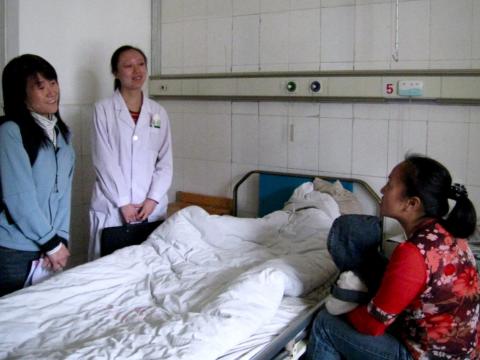Child Health: 20 years of service in rural China

It is hard to tell that Dr. Christy Fong, with her youthful appearance, has been working with World Vision for about 20 years. She is now the head of World Vision China’s health department.
Looking back at when I first started working in Mainland China, there was no policy on subsidized hospital deliveries in China. In the poor areas served by World Vision, it was common to have village women assist the pregnant women to deliver at home. Using traditional methods they used any sharp object they could find to cut the umbilical cords of the newborn.
Even if there were hospitals, they were often inadequately equipped with facilities or well-trained medical staff. The hospitals were also too far away from the villages. Should something happen to the mothers during delivery; it was difficult to ensure timely and effective treatment. As a result, the national infant mortality rate could be as high as 30-40 deaths for every 1,000 infants born alive. This figure is now down to 12 deaths (UN, 2015).
With the commencement of Millennium Development Goals, many improvements were accomplished globally in child health, especially in diseases preventable by vaccines. These changes are gratifying, but unfortunately child nutrition has not received the same level of attention as disease control.
The World Health Organization has published a set of data showing that globally the main reasons for the deaths of children under 5 years of age include complications from premature births, pneumonia, diarrhea, etc., out of which about 45% of the deaths are related to malnutrition (WHO, 2014).
In the rural areas of China, there are comparatively more deaths because of pneumonia and diarrhea for children under 5 years of age.
In the rural areas of China, there are comparatively more deaths because of pneumonia and diarrhea for children under 5 years of age. In view of this, World Vision globally and as well as in China, started adjusting the focus of its health goals.
One of the key nutrition targets is to promote exclusive breastfeeding for the first 6 months. And for the past few years, World Vision China and local health partners and communities have embarked on this challenging road.
Mothers can be easily persuaded by the many milk powder advertisements and stop breastfeeding their babies.
Mothers can be easily persuaded by the many milk powder advertisements and stop breastfeeding their babies, but breastfeeding is the most economical and environmentally friendly.
The World Health Organization recommends that a mother exclusively breastfeed her baby for the first 6 months, and then followed by complimentary feeding and continuing breastfeeding until the age of 2.
Breastfeeding babies exclusively for the first 6 months can decrease the chance of these babies having cancers, overweight and obesity, diabetes during childhood and when they are older.
Gender and health
We work in Gansu province, helping prevent and control tuberculosis. Many female patients did not receive the same level of care as male patients. We focused on working with the health system to improve the access to TB care among the female patients.
Apart from improving the quality and accessibility of service, it is very important that we can encourage people to do more for their local area. One of the challenges in health development work is striking the right balance. When faced with limited resources, communities at large may not necessarily put the needs of children as a priority, but our ultimate goal is to reduce the deaths of children.
It is essential to support the communities so that they ensure children have the rights to good health and nutrition. This will be the ideal child-centered community development work.
I have worked persistently for years in community development work. It is no longer a job but a mission. I see change. Change in the people, in the community I serve, and in myself.

